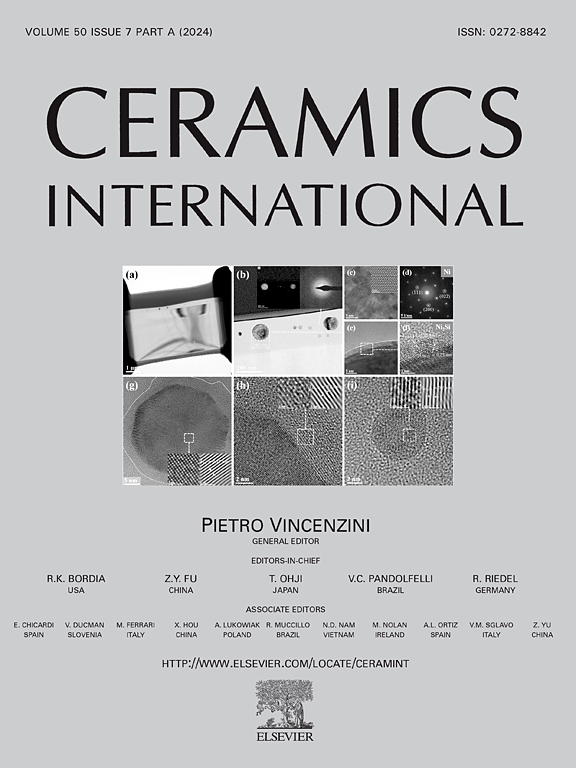Realizing wear-resistant Cr2O3 coatings using finer feedstock: Role of diverse plasma spray torch configurations
IF 5.6
2区 材料科学
Q1 MATERIALS SCIENCE, CERAMICS
引用次数: 0
Abstract
This study investigates the microstructural, mechanical, and tribological properties of Cr2O3 -based coatings deposited using finer feedstock with three different plasma spray torches: the traditional 9MB torch, the cascaded SinplexPro (SLX) torch, and the Axial III (AXL) torch. The specific objective is to achieve denser Cr2O3 microstructures; thereby, enhanced wear resistance and mechanical performance shall be realized. Detailed characterization and performance analysis, including X-ray diffraction (XRD), scanning electron microscopy (SEM), sliding wear tests, wear track profiling, coefficient of friction measurements, etc., were conducted to evaluate the influence of torch configuration on the resulting coatings. Phase analysis confirmed that the AXL coating displayed similar XRD peak intensities of all planes as that of feedstock, indicating that the axial spray coatings retained the structural characteristics of the original feedstock powder. SEM and wear studies revealed that the AXL coating, characterized by its dense microstructure and minimal porosity, exhibited superior hardness (12.1 GPa) and least specific wear rate (0.1 × 10−6 mm3/N-m). In contrast, 9MB and SLX coatings showed relatively higher porosity, lower hardness, and increased wear rate. The study demonstrates the critical impact of torch design towards achieving dense coating structures and highlights the combination of fine-sized feedstock fed in axial injection mode, eventually producing coatings with enhanced wear resistance and mechanical properties.
使用更细的原料实现耐磨Cr2O3涂层:不同等离子喷涂炬配置的作用
本研究采用三种不同的等离子喷涂炬:传统的9MB喷枪、级联的SinplexPro (SLX)喷枪和Axial III (AXL)喷枪,研究了采用更细的原料沉积Cr2O3基涂层的显微组织、力学和摩擦性能。具体目标是实现更致密的Cr2O3显微组织;从而提高耐磨性和机械性能。通过x射线衍射(XRD)、扫描电镜(SEM)、滑动磨损测试、磨损轨迹分析、摩擦系数测量等详细的表征和性能分析来评估焊枪配置对所得涂层的影响。物相分析证实,AXL涂层在各平面上的XRD峰强度与原料相似,表明轴向喷涂涂层保留了原原料粉末的结构特征。SEM和磨损研究表明,AXL涂层具有致密的微观组织和极小的孔隙率,具有较高的硬度(12.1 GPa)和最小的比磨损率(0.1 × 10−6 mm3/N-m)。相比之下,9MB和SLX涂层的孔隙率较高,硬度较低,磨损率较高。该研究证明了火炬设计对实现致密涂层结构的关键影响,并强调了轴向注射模式下细粒度原料的组合,最终生产出具有增强耐磨性和机械性能的涂层。
本文章由计算机程序翻译,如有差异,请以英文原文为准。
求助全文
约1分钟内获得全文
求助全文
来源期刊

Ceramics International
工程技术-材料科学:硅酸盐
CiteScore
9.40
自引率
15.40%
发文量
4558
审稿时长
25 days
期刊介绍:
Ceramics International covers the science of advanced ceramic materials. The journal encourages contributions that demonstrate how an understanding of the basic chemical and physical phenomena may direct materials design and stimulate ideas for new or improved processing techniques, in order to obtain materials with desired structural features and properties.
Ceramics International covers oxide and non-oxide ceramics, functional glasses, glass ceramics, amorphous inorganic non-metallic materials (and their combinations with metal and organic materials), in the form of particulates, dense or porous bodies, thin/thick films and laminated, graded and composite structures. Process related topics such as ceramic-ceramic joints or joining ceramics with dissimilar materials, as well as surface finishing and conditioning are also covered. Besides traditional processing techniques, manufacturing routes of interest include innovative procedures benefiting from externally applied stresses, electromagnetic fields and energetic beams, as well as top-down and self-assembly nanotechnology approaches. In addition, the journal welcomes submissions on bio-inspired and bio-enabled materials designs, experimentally validated multi scale modelling and simulation for materials design, and the use of the most advanced chemical and physical characterization techniques of structure, properties and behaviour.
Technologically relevant low-dimensional systems are a particular focus of Ceramics International. These include 0, 1 and 2-D nanomaterials (also covering CNTs, graphene and related materials, and diamond-like carbons), their nanocomposites, as well as nano-hybrids and hierarchical multifunctional nanostructures that might integrate molecular, biological and electronic components.
 求助内容:
求助内容: 应助结果提醒方式:
应助结果提醒方式:


